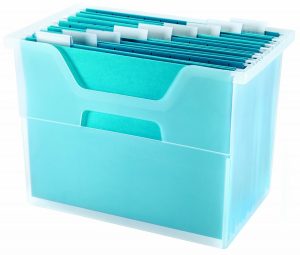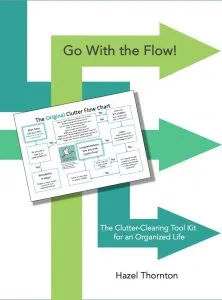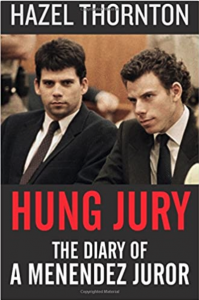Mystery Piles & Action Files
 Have you ever heard the organizing rule, “Touch each piece of paper only once”? (a.k.a. OHIO — Only Handle it Once) Well, it’s a myth. But the kernel of truth inside the myth is this: If you sift through a pile of mail, or other type of papers, and if you don’t decide the first time you touch it what ACTION needs to take place NEXT, you will just have to sift through the pile all over again later. Pretty soon you will end up with what I call a mystery pile. It keeps growing, and who knows what’s in there?
Have you ever heard the organizing rule, “Touch each piece of paper only once”? (a.k.a. OHIO — Only Handle it Once) Well, it’s a myth. But the kernel of truth inside the myth is this: If you sift through a pile of mail, or other type of papers, and if you don’t decide the first time you touch it what ACTION needs to take place NEXT, you will just have to sift through the pile all over again later. Pretty soon you will end up with what I call a mystery pile. It keeps growing, and who knows what’s in there?
So, what is the easiest way to vanquish mystery piles – and the missed deadlines and opportunities they usually represent? By using an action file!
Use an action file to vanquish your mystery piles of paper! Share on X
How to create an action file:
- Get yourself a vertical table-top file. It’s only 6” deep, holds letter-sized hanging files, and has no lid. Keep in mind that these files are for temporary use, not for permanent storage. If you get a bigger one you will be tempted to store things in there that really need to be tossed or filed. You will need 5-7 files. Label the files with ACTION words such as PAY, CALL, FILE and WAIT. Your personal categories will become clear as you sort your own mail. Use action words (verbs) that are meaningful to you. If you have a spouse or roommate, you might want one that says ASK SO-AND-SO.
- Sort your mail as soon as you bring it into the house. It will only take a minute, really! Keep your action file in a very prominent place, so that it will be easier to use than it is to not use. (Hint: Where does your mail tend to pile up now?) Don’t give in to your temptation to use a file box with a lid. You will get tired of opening and closing it, trust me! Toss junk mail directly into the trash or recycle bin, which should be located within arm’s reach of your action file if possible. Shred credit card offers and other unwanted mail with sensitive information on it.
- What goes in which folder? Unpaid bills go into the PAY folder, unless you have a question about one of them, in which case it goes into the CALL folder. Later, when it is time to actually pay the bills you have accumulated, you can remove the entire PAY folder, take it to your bill-paying spot, and pay them all at once. Invitations requiring RSVPs would first go into the CALL folder. Then, once you have called to RSVP – and have entered the event on your calendar – you can toss the paper, or keep it in the WAIT (or “PENDING”) file for the directions or other info you will need when the time comes. Another example of WAIT would be a rebate you have applied for and are waiting for the check to arrive. Or maybe you are playing phone tag with someone and the ball’s in their court. Nothing should go into WAIT until after you have entered a follow-up date on your calendar. Statements, paid bills, project ideas, etc. go into the FILE folder. I have a READ AND CONSIDER file for things that require a decision. (If there’s a deadline for deciding I write it boldly on the paper.)
- This is the time for sorting, not doing. You may have dinner on the stove, or perhaps you’re sorting your mail at midnight, or another inappropriate time for making calls. That’s OK. You don’t need to worry about when things will get done if you have scheduled a regular time to pay bills, make calls, do your filing, etc. And now you will know exactly where the papers are that you need when that time comes.
- Maintain your system. Schedule time to DO the actions, including FILE. How often you file depends on how fast your FILE folder fills up. Maybe weekly, maybe monthly. Don’t let the file folders get so full that you can’t put papers in and take them out easily.
Now you can enjoy your clutter-free counter, and the peace of mind that comes from having a system that works!
Do you have mystery piles? Do you think you could use an action file?
Or, do you have another method that works for you?
Please share in the comments below!
—————————————————————————
Copyright 2007 – 2015 by Hazel Thornton, Organized For Life.
Social media links directly to this page are encouraged!
Please contact me for other types of reprint permission.
—————————————————————————
Share this:







[…] couple of weeks ago, I ran across this blog post by Hazel Thornton at Organized for Life. Hazel’s a professional organizer in Albuquerque, and […]
Thanks for including my tips in your blog post, Elizabeth! It makes me happy to hear I inspired you to take action!
Thank you for these amazing tips. I have made my action file and I am looking forward to implementing it. My next step is to use your tips on creating a filing system that works for me. I appreciate the time and effort you spend to share these things online. Thank you!
Heidi
I’m glad you found my post useful, Heidi. Tell your friends! Subscribe to my blog! Sign up for my newsletter and get a free Original Clutter Flow Chart!
Hazel, I have created action files at least twice but never gotten into the habit of using them, so of course I still missed things I needed to do (and started making mystery piles again). Can you give us any tips for getting started actually USING them–specifically for people who are accustomed to the mystery piles?
Hi Jen, the topic of creating new habits is a big one. But specifically, for this, I recommend 1) An inbox for corralling incoming paper, if you don’t want to sort it immediately into your Action File; 2) placing the inbox directly next to the Action File, and both in such a prominent spot (kitchen counter? entryway?) that it is almost easier to use them than to not use them.
GREAT ideas! Now to find a place like that to put them…
Hazel, I just referred this to a client. We both love this post! I will be referring to it often. Thank you!
You’re welcome, Ericka!
I’m definitely on the same page with this one. The biggest mistake I see is not that people touch a piece of paper multiple times, it is that they touch it without moving it one step closer to completion. Putting a paper into an action file moves it closer to completion, as does picking it up and making a call or picking it up and checking something pertinent on the internet. But just picking it up, looking at it, and and then putting it right back into a big pile is where you get into trouble.
Exactly! The action file only moves the item one step closer to completion, though. I’ve had clients who are good at putting things into the file and really need coaching on the part where you take things out later and DO them. LOL!
Such a practical post. I love that you included a step for maintenance which means scheduling time to file! So often the filing aspect gets overlooked and that pile can start to take over.
Ha ha — see my reply to Seana just now. 🙂
Great post. I frequently recommend an action file box for my clients. One of the big problems a lot of wives seem to have is mail for their spouse, especially where I live where it seems like a lot of husbands are deployed or away a lot for work. I often suggest having a separate basket to put his mail in, rather than letting it buildup on the counter.
Yes. Anything that is too big or bulky (magazines and catalogs, oversize insurance or medical folders, etc.) or that will not be done anytime soon (piling up and waiting for someone else) belongs in a separate inbox. This is obvious to organizers. Not so obvious to clients.
Hi Hazel,
I am going to share this with one of my clients. I hope it will be helpful to her. I see a lot of people with lost opportunities due to pieces of paper which have gotten lost in the shuffle. An Action File is such a great idea as long as the person is able to work on that action. Personally, I do tend to procrastinate around paper organization but I do get to it eventually (with some reluctance) Scheduling the time and day can really help.
Hazel, I love this system of only having three or four ACTION files. I’ll admit I am a mystery piler until I get ready to file. Though I have named my action files differently this is the method I use. Also, scheduling time to do the action is so important I have to write it on my calendar as well! Thanks for the great post!
Glad you liked it (and thanks for sharing it), Autumn! Yes, the fewer the better, as long as they capture the sorts of things you actually do with your paper. 5-7 maximum. I only named a few because the rest really depend on the person. And scheduling actions is key!
I have bills set up Automatically for bill pay. When bill comes, I edit amount and date. File bill in monthly folder.